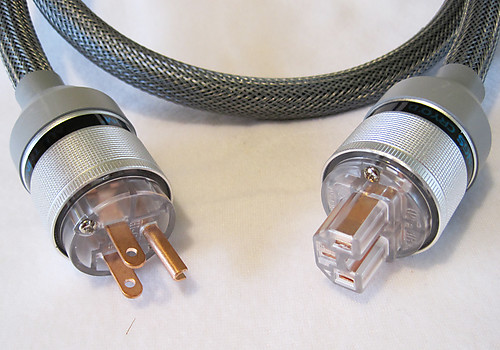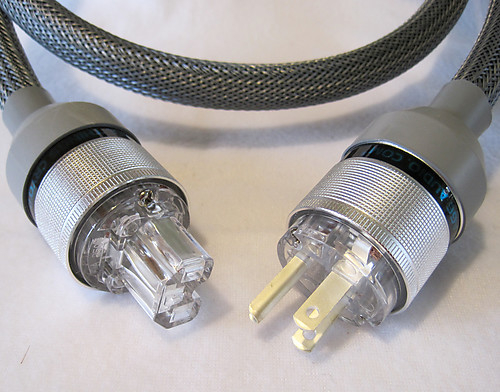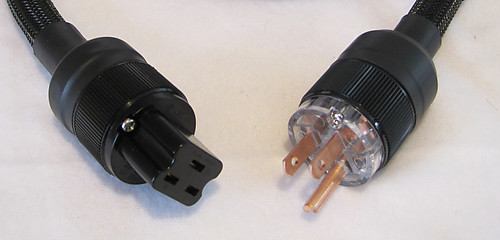Ice Age Audio Power Cables
Sooner or later, audiophiles come to realise that the cords provided with their components might not have been developed with anything more than convenience in mind. At this point, your options are to either convince yourself that cords don’t really matter – any wire with the right connectors will suffice – or to justify buying replacement cords, often at a price that seems quite disproportionate to the money already spent on each component.
Everyone eventually takes a position on this, and there’s no end to forum discussion on the value or not of investing in cords. I agree with those who bemoan the lack of compelling empirical evidence for differences but I also know that I have heard benefits from some new cords on my components and accordingly, have invested my own money in wire over the years. To my mind, if you can hear a benefit, it does not really matter what anyone else thinks – even if it does rankle that there’s more than a whiff of marketing BS in much of the literature on power cords in audio.
So, it’s a pleasant surprise to experience a relatively new line of power cords from Ice Age Audio, consisting of the father-and-son team Rick and Brodie Parker. Offering a range of cables (including HDMI) that seem to have quality copper and silver plated parts, cryogenic treatment (hence the company’s name) and build-your-own options for prices starting at $69.95 and climbing the ladder to $179 for their top, 5 ft. carbon-fiber model, Ice Age Audio aims to deliver a step up in performance for those audiophiles who believe there are improvements to be achieved through a little investment in better materials and connectors.
If this sounds like Ice Age Audio is a form of cottage industry, well, I think it is. Rick does not describe himself as a ‘manufacturer’ as you typically envision the term, but more as an enthusiast who started to play with materials, became convinced in the value of cryogenic treatment, and then started selling cables to fellow enthusiasts for little more than cost. Over the years, he and Brodie have developed the process, created models that mix and match copper and silver materials, and even offer the basic parts unassembled for those keen folks who want to build their own. Indeed, you can build one of their cords for so little that you might be tempted to do so – until you look at the final cost of having IceAge do it for you whereupon you will quickly realize how little they are charging for the labor. This is not your regular audiophile wire company.
I received four samples of the Ice Age Audio line, all 10AWG, 5 ft cords, of varying thickness due to the specific insulation used on the copper or silver, including one fitted with the right 20-amp connector for my phono stage. These were their Copper/Silver, Copper/Copper, 20AmpC19, and Silver/Silver models. Finish quality is high: these all look and feel well made. The essential difference between the models is the metal mix: copper wire with copper plugs, copper wire with silver plugs, or silver-plated copper wire with silver plugs. It’s not difficult to determine which is which when you know this basic set of distinctions but it would have helped quick comparisons for each to have a label, especially since some thought has obviously gone into the look and feel of the power cords.

IceAge Audio Copper/Copper Power Cable
Alright – but how do they sound?
Thinking about the ‘sound’ of a power cord is enough to switch some folks off so let me try to keep this simple. In my system, some but not all cords have made a subtle but meaningful difference to the sound I hear. For example, the Thunderbolt cords that Spectron briefly produced for their own amps, a pair of which I snagged before they determined these were not cost-effective to continue selling, brought those monoblocks to life like nothing else I tried. I still feel these are the best cords you can get for the Spectrons, giving the amps a little more of everything that matters to my ears. I’m not sure of the secret but there’s a ton of copper in there and they are pretty unwieldy in use. I also found that Gary Koh of Genesis’ line of Absolute Fidelity cords were a particularly synergistic match with the SMcAudio VRE-1 preamp. Other than that, I’ve stuck with a variety of cords I’ve accumulated over the years that at one point or another seemed to improve things a little over stock.
I started by putting the 10 AWG Copper/Silver on my Raven Blackhawk integrated tube amp. This amp came with a similarly thick stock cable that was designed by Raven for their own amp and which I’ve happily used for over a year. Fed from the wall or from an AudioPrism PowerWedge conditioner, I could not tell the difference in casual comparison, and even after straining over several sessions would not place any money on my ability to discriminate meaningfully between the two cords. Given the Raven cord is definitely a step above the typical stock cables most manufacturers provide, I took this as an encouraging sign. The IceAge Copper/Silver could hold its own nicely.

IceAge Audio Copper/Silver Power Cable
The Copper/Silver cord did, however, surprise me when I tested it on one of my Spectron amps. I listened to a single Spectron in stereo mode with the dedicated Thunderbolt cord before swapping the IceAge audio cord in and out over a period of several weeks. Now, I have never found any cord to match the Thunderbolts on the Spectrons, so imagine my surprise when I put the Copper/Silver in and actually felt it matched the ‘bolt in every way. Spectron’s late distributor, Simon, had told me the secret to the Thunderbolt was the sheer amount of copper in the cord, and it feels like it – these are big, snake-like cords that you have to coax into position. The IceAge 10AWG Copper/Silver is also relatively thick but handles much easier, looks better, and it too sounds great on the Spectron – better than spares from Pangea (a 9AWG monster) and a WyWires cord that I find works best on front-end components.
For completion, I tried the Ice Age Copper/Copper in the same rig but while it sounded good enough, it was the Copper/Silver that held the edge in this setting, with just a little more life in the top end to make it pleasing to these ears. I don’t know that I’d recommend one over the other but the point is moot – you can’t get the ‘Bolts anymore. In their absence, let me recommend Spectron amp owners give the IceAge Copper/Silver cord a try. I’d wager that it gives whatever cords you are now using a serious run for their money.
Since Ice Age had provided a 20 Amp model just for my Audio Research Ref 2SE phono stage, this is the cord I used one for the longest period, and it gave me a very interesting sense of the value on offer. ARC’s own cable is no slouch – it looks relatively standard but other owners claim they have a hard time besting in with aftermarket options. There’s even a rumor on one audio forum that ARC had the cable supplied by Shunyata for the phono stage. I can’t speak to that but I do know that I expected the Ice Age to be shown up here as the weaker of the two options.

IceAge Audio 20 Amp Power Cable
Instead, what I heard when I swapped the cords, and what I continue to hear as I go back and forth between them, is that the Ice Age gives the phono stage bass a small boost without obviously compromising the other frequencies. This is an interesting experience as the Ref2SE is not bass-shy at all. In its stock form it has given me the best analog reproduction I’ve heard in my room, a full, rich, resolving presentation that just makes listening to vinyl addictive. Add the Ice Age Audio C19 and the reproduction changes subtly but audibly, with those lower frequencies taking on a bit more body and presence. Now I’ll leave it to you to decide if your system benefits from this but I quite enjoyed the results. Over several months of back and forth, I can listen to either cord and be happy but I bet for some folks, the shift offered by Ice Age will be a welcome adjustment. Since you can purchase a 5ft length for under $130, owners might consider this cord an affordable tweak on this pricey phono stage.
It’s difficult to say a lot more about power cords. In delivering the power to enable the component to operate they either choke a component or let it breathe. Sometimes a cord can make everything sound better but in my rig the effect is usually slight – a minor constraining or liberation of the soundstage, slightly fuller bass or cleaner upper frequencies. If you get ‘component-change’ impact from cords, then good luck to you but I’m glad when a replacement of stock cords reveals just enough more timbral reality and sonic ease to make me feel things are working as they should.
By these measures, the Ice Age Audio cords are simply great. For the price, they improve on most stock cords and compete with some more expensive cords I’ve tried. They are well made, they look and feel like you are getting your money’s worth, fit components securely, and most importantly, they allow the quality of your components to shine. There’s no magic here, no spoof science, just well chosen materials, solid workmanship, and really sane prices. Enough said – there’s a new value leader in the power cord business. Go Rick and Brodie!
To learn more, and to order, see: http://www.iceageaudio.com/.
Q&A with Rick Parker of Ice Age Audio
Intrigued by the emergence of an affordable power cable company entering a rather saturated market, I thought it would be useful for readers to learn a little more about Ice Age Audio. Here are a few responses from chief Rick Parker to my prodding about the origins and aims of his company.
PD: So, Rick, what was the driving motivation to start yet another audiophile cable company?
RP: I have owned many different types of businesses, but the number one thing I’ve done with all of my companies is try to offer the best product I can at a reasonable price and openly offer an education of the product to those who have the interest in learning. The audio industry is one of many industries with minimum manufacturing costs and very high retail pricing. Cables can cost a ridiculous amount with no explanation as to why. Not to say that some aren’t worth it, but there are too many companies/people taking advantage of the naïve and uneducated within this hobby. I was introduced to the idea of power cord upgrades in 2009 and was also made aware of what cryogenic treatment could do to improve the end result. I bought my first cryo-treated hospital grade cable to try on my 6-tube 2-chassis preamp and I was blown away by the results. That’s what started this new journey of educating myself on cables, metals and cryogenics.
I read many articles on cryogenics and its affects on assorted metals. I first started working with Bryce at NitroFreeze who was very helpful in walking me through the process and giving me a basic understanding. We started small just to see what the response would be. Initially we were attempting to break into the video market with TV power cords and HDMI’s. My thought was people are spending 1000’s of dollars on TV’s and using 99 cent cables to make them work, starving the piece of electronics of its full capabilities. We had minor success simply because the general public is not concerned or aware of what a cable can actually do to change the performance. We tried this for about a year then decided to look at high end audio power cords and that’s when things took off. We made some prototypes for testing and photos and the rest, as they say, is history. Our success has been phenomenal considering this was started as something to play with in a hobby that we enjoy. We are literally on every continent at this point and continue to grow. As we state on our website, this is a hobby, not a living. Even though it has turned into a viable business.
PD: How do you keep prices where they are given you do not have mass-production?
RP: When we originally started this company we were purchasing supplies in small amounts not knowing whether we would sell anything or not. We set our selling prices at a reasonable margin and waited for results. Over time we refined our resources and started building working relationships with our suppliers. When we first started we were buying plug sets 5 at a time, we now buy them by the hundreds. We originally bought wire 50 to 100 feet at a time, now we buy multiple rolls at a time. We work with a local cryo facility, Industrial Cryogenic Engineering, which is 20 miles from my house so the service is exceptional. So as we’ve grown our costs have dropped and we’ve been able to keep our pricing at a very competitive rate. We don’t inventory cables, we inventory parts in bulk. All of our cables are custom built at the time the order is placed. That is why we can offer so many options as far as lengths, metals and colors. We can build any gauge, any length and any metal combination by simply asking us to. We are a home based operation, no overhead, no employees. We are a family owned and operated business consisting of my son and myself. I am in the process of building a new home and there is a dedicated shop area included for future production as the company grows.
PD: So, what are the future plans for Ice Age Audio?
RP: While we are currently doing power cords and HDMI’s, we do have plans on venturing into speaker cables and interconnects and possibly even some USB applications once we are in the new home. We have all of the parts currently on hand but these items are much more labor-intensive to produce, and we want to do it right. We’ve made a few prototypes and test pieces for personal use and close friends and have seen positive results. We don’t want to jump into this until we feel we have a product that is truly worthwhile and at a competitive price. We are always looking at new products, wires, metals and end results so our R&D work is ongoing. The most common statement made by our customers is that our cables sound better than cables costing 3-10 times as much. We don’t claim to duplicate the sound of a $1000 cable, but our $100 cable has a proven track record with global popularity. We openly invite everyone to call, text or email us with any and all of their questions and we take care of each and every one of them on a one-on-one basis.




Hello One & All Ive been around the Audio Industry For 55 plus years I have been fortunate to own What was considered the best of the best In Power Amp Speakers Etc I have had the pleasure of in-house tours from industry Ceo s With Out mentioning any name s No longer Buying into Magazine ads & reviews stating a euphoric experience I settle down with both Feet on the Ground to take sensible approach to those that have passion in there Hearts & want the same fulfillment Now enough said I stumbled across a Company That shares the same ideas with True Passion I am talking about ( who’s name YES I will Mention is Rick Parker & his Son Of Ice Age Sound & Audio In this day & age when the company owner can spend TWO Hours discussing all of the above & more You Sir Have My undived attion i have purchase Two of Mr Parkers Copper on copper Power Cables As soon i have spent 200 HOURS OF testing I promise a Full Review Thank you greg Leary a PROUD USMC Veteran